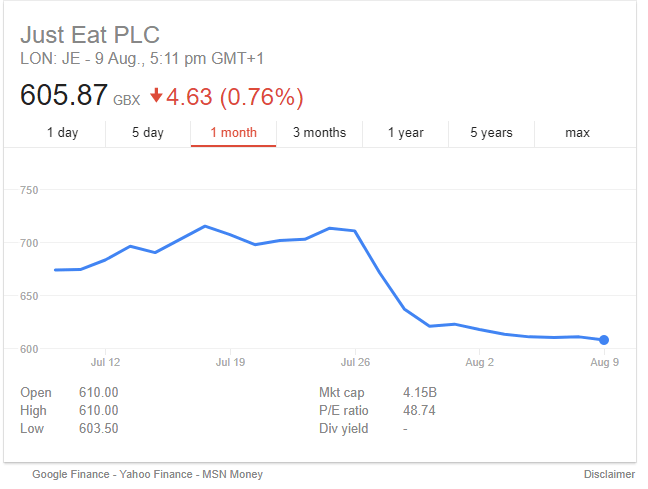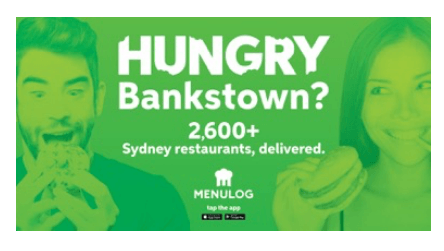The Just Eat share price has fallen 15.1% in the last two and a half weeks as concerns mount about their ability to grow revenues. This comes after the 26 July release of what on the face of it was an upbeat Half Yearly report. We break down the numbers to look at what may have caused such a big sell-off, highlight some of the concerns for Just Eat moving forward and look at why Restaurants are looking to decrease their reliance on Just Eats platform.
Just Eat restaurant metrics breakdown
Just Eat announced the following metrics for the half year:
- 80.4 millions orders, up 24%
- 19 million active users up 19%
- Restaurants 75,400 up 14%
- Revenue of £246.6m which was up 44%
- ARPO £2.84 up 15%
- UK Orders 42 million, up 18%
- UK Revenue 140 million, up 27%
- Australian orders 6.4 million, up only 16%
- Australian revenue 23.6 million, up 37%
Interestingly enough, they define an active user as a user who has ordered at least once in the last 12 months, which isn’t very active.
Orders per Restaurant only increased 8.9% for the half and yet revenue per restaurant increased by almost 3 times as much at 26.4%. It is clearly unsustainable to to extract more revenue from cash strapped Restaurants.
The average Restaurant with Just Eat gets 41 orders per week. This seems quite low, our experience is that take-outs can do up to 60% of revenue in six hours, the time between 6 PM and 9 PM on Fridays and Saturdays.
Average order frequency has grown 29% in four years, showing quite slow growth for customers using the platform and at face value it would appear that acquiring a new customer is where they experience most of their growth, not in getting existing customers to order more often, with customer order frequency only growing 6.5% per year.
Why did the Just Eat share price fall?
Investors overwhelming concerns will be about Just Eats ability to continue to grow at the rates that it is expected. Its current P/E is 48.37 (the Price / Earnings ratio, a measure of how expensive a stock is, factoring in expected future earnings), which is quite high and implies strong annual growth rates. A slowing of earnings growth will imply that the share price will need to decrease to support a lower P/E ratio.
Revenue growth outstripping orders growth. Revenue has grown at 44% but orders only grew at 24%. Looking into the UK / Rest of world breakdown creates an even bleaker picture with UK orders only increasing by 18%. International orders grew 35% reflecting the less mature markets that they are operating in and revenues grew 75%. The difference between order growth and revenue growth comes predominantly from Top Placement revenue which will be limited by the underlying profitability of Restaurants. Many Restaurants are borderline profitable, and the 13% commission is generally viewed as very expensive by Restaurant owners. As free alternatives to Just Eat become increasingly popular, there will be a limit to the growth of revenue from Top Placement.
With orders growth slowing, earnings growth will also slow as Restaurants become increasingly reluctant to pay higher commissions.
Overpaying for companies like Menulog. In an effort to scale globally, Just Eat has bought a range of companies around the world. Just Eat paid a whopping AUD $865 million for Menulog in Australia, on a P/E of 369. The last results saw revenue growing by 37%, most of that growth came from Average Revenue per Order increase o 26%. Order growth was only 16%. This is a reflection of Menulog’s retreat from the Capital Cities as it faces fierce competition from UberEats and Deliveroo. (We expect Foodora to withdraw from Australia imminently.) Just Eat still has a stranglehold on areas where Deliveroo doesn’t operate, but here are limits to the increases in commission that Restaurants will be able to bear. There is an implicit nod to this fact in the Results with the discussion of the focus on second tier city activations. These are areas yet to be penetrate by Deliveroo.
With order growth of just 16% in Australia, Just Eat will be waiting a very long time for a return on its $865,000,000.
Risk from vertical integration from chains. Much has been made from the move to work with branded restaurants, which Just Eat admits is a challenging model. Just Eat will face resistance from the commission charges to the branded restaurants and any chain doing significant volume from Just Eat would be able to save virtually all of that by creating their own online ordering solution. More and more chains are becoming increasingly concerned abut who owns the customers details and so there will be more in-house built solutions guaranteeing that the Restaurant doesn’t need to use a 3rd party to collect customer details, or they will use competitors like FROLO which never share customer contact details.
Just Eat was a pioneer in online eCommerce for Restaurants, but in 2001, the costs of developing online eCommerce solutions was 100x what it is today and the frameworks and integrations today make bespoke in-house eCommerce trivial for chain and branded Restaurants.
Risks of a consumer backlash. Almost all consumers are unaware of the steep commissions that Just Eat charges, nor of the effect that Just Eat has increasing Restaurant food prices as Restaurants attempt to cover the increasing fees to Just Eat. We are also seeing an increasing in low quality Restaurants attempting to compete on price. We are also seeing a growing trend of Restaurants using alternatives to Just Eat and running “Order direct from the Restaurant and save campaigns.” In Australia, Menulog has tried to create the verb “Menulog”, as in “Just Menulog It”. This has been successful as we are seeing an increase in “Menulog and Chill” tweets and Facebook posts, but we are also seeing a rise in customer complaints where the customer is failing to make the distinction between Menulog and the restaurant preparing and delivering food. This leaves Menulog particularly susceptible in UberEats and Deliveroo services areas, where more work is done with Restaurants to ensure a quality product.
Increasing competition to Just Eat slowing revenue growth.
Just Eats has seen fierce competition from Deliveroo, which is charging 30% commission + £2.50 per delivery, but their popularity stems from their ability to solve the logistics problem for Restaurants. The actual delivery of the food is something that Restaurants have struggled with traditionally and many are glad to have someone else solve that problem for them. UberEats is also starting to grow market share.

Bankstown is an area Menulog is focusing efforts on, being outside the UberEats sphere of domination.
The above example shows the focus on concentrating on Restaurants outside the zone of influence of UberEats and Deliveroo where Menulog and Just Eat struggle to compete.
What is Just Eat top placement and why is it bad for the restaurant industry?
Just Eat has a feature called Top Placement, which is where Restaurants can pay an increased commission in return for being listed at the top of search results in an area. The problem with it is that it is often Restaurants that are struggling with revenue issues who use the Top Placement feature in an effort to bring in some quick cash. This can be coupled with an incentive for customers, such as 10% savings. Top Placement makes it harder for Restaurants with great food to compete because we see a higher number of Restaurants that fail using the Top Placement feature as an act of desperation to try and survive, decreasing the number of order that are available for great restaurants with great food.
According to a recent job ad, Top Placement accounts for 6% of revenue globally, and is sold with structured cold calls using data from dashboards. Just Eat Canada states that Top Placement can increase average sales by 20%.
Our issue with Top Placement is that it is often used by Restaurants that are struggling or low-cost restaurants focusing on a price point and not on the quality of the food as well as the interface which makes it hard for Restaurants to compete on anything other than price, listing order and specials offered.
Where will future growth come from for Just Eat
Just Eat has a number of ways to grow revenue in the future.
- Attempting to drive consumer demand for delivered meals at lunch and breakfast. In our experience, there is a lot of work to do to create viable breakfast delivery services.
- Increasing commissions, although Restaurant profitability will limit this.
- Expanding into new countries where possible, but much of the land grab has already been done between Just Eat, Grubhub and Delivery Hero.
- Increasing customer order frequency, although this has only been growing at 6.5% per annum.
The question remains at what point will Restaurants moving to Free Restaurant OnLine Ordering services, which provide almost the same features, collect the customers contact details and do it commission free and to Uber Eats and Deliveroo, who solve the logistics issue, outpace the increase in revenues that it is seeing now.
The future for Just Eat?
We believe that Just Eat will struggle against Deliveroo. The solving of the logistics problem is often seen as a simple solution, especially when Just Eat is charging 13% against 30% + £2.50 per order with Deliveroo. UberEats will be aggressive as well in looking for market share. Where it will prosper is in areas where Deliveroo can’t operate. Deliveroo faces the difficulties of operating in a 3 sided business, it needs a density of Restaurants, customers AND delivery riders to be able to make this work.
It is only feasible in areas with high-densities of all three, especially given the high demands in peak periods. This leaves Just Eat as the only choice in outer areas. This will only increase if HungryHouse is allowed by the to be purchased by Just Eat from Delivery Hero. The proposed acquisition is currently being examined by the Competition and Markets Authority in the UK. In Australia, we have seen a strong monopoly develop with Just Eat subsidiary Menulog, after it purchased number two-placed Eat Now, and Delivery Hero exited the market. They have seen market share eroding significantly in the capital cities, but have created very strong monopolies in outer areas not served by UberEats and Deliveroo.
What are the alternatives to Just Eat for online orders?
We are seeing a massive opportunity with Restaurants using the Free Restaurant OnLine Ordering system. This enables Restaurants to take unlimited orders with cash or credit cards, and it more importantly allows Restaurants to build a database of customers who are ordering from them. If you don’t own the email address, you don’t own the customer.
Many Restaurants are able to take the savings from not paying 13% commission, spend 6% on Facebook marketing, grow their Revenues aggressively and pocket the difference.
To get a better idea of the economics of Online ordering and Take Out, listen to the Secret Sauce Podcast special 2 part report on maximising take-out orders.
If you are looking to cut Just Eat’s commission and to start building your database, sign up today for FROLO, the best alternative to Just Eat.
Is Poor SEO Killing Your Restaurant?
Too many times we see customers with websites that are costing restaurants thousands of dollars every month through poor design, poor messaging and poor SEO. If your website could be improved to bring in 200 extra visits per month and just 10% of those made a booking, and each booking was for 2.5 seats on average at $50 a seat, you would have an extra $2,500 in revenue a month. A 30% food cost, that is $1,750 in profit extra a month. This ignores those customers coming back as regulars – which is more profit.
Remember, if these customers aren’t finding your Restaurant, they are finding your competitors.
Get one of our obligation free 7 point website SEO audits to see what you can get your web developer to fix to increase your revenue today.





